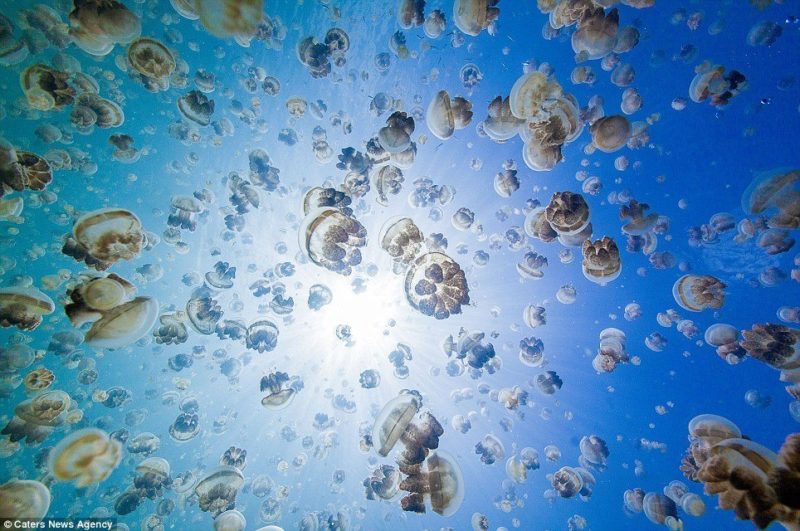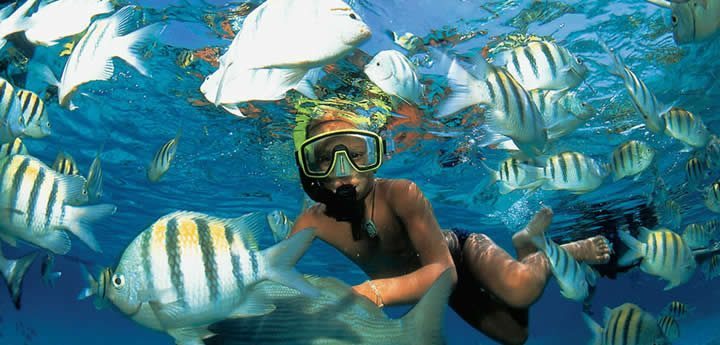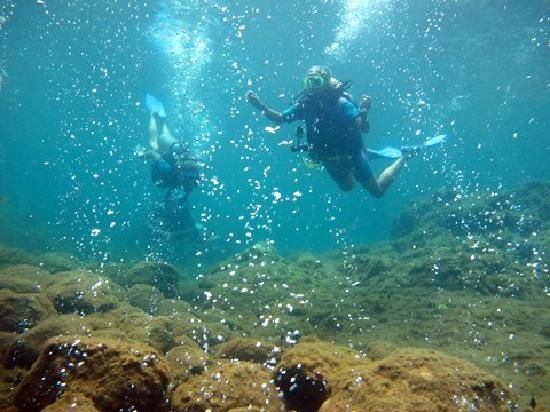Last Updated on June 25, 2023 by Snorkel Ken
Snorkeling isn’t all just coral reefs and tropical fish. If you need to get away from the usual snorkel scene, why not try swimming off the beaten path? Instead of just hoping you will see something new at your typical snorkel spot, look for an adventure that takes you above and beyond your comfort zone. From underground waterways to shivering with whales in the Arctic Circle, adventures aren’t just for scuba divers, those with a snorkel mask and a good set of fins are sure to find a thrill in these unusual snorkel spots.
Under Water Museum, Grenada

Everyone knows about MUSA, the underwater sculpture park outside of Cancun, but that is not the only sculpture park made by Jason deCaires Taylor. He actually has a few, another of which lies off the coast of Grenada in the Caribbean. Unlike the park in Cancun, this isn’t just tourist fodder. In 2004, Hurricane Ivan completely wrecked the ecosystem in Moliniere Bay just north of the island’s capital of St. George. However, Taylor came in and built a 65-piece sculpture garden to help repair the ecosystem, and it worked! Pink sponges now grow on life-sized statues of men creating some weird alien creatures, little fish dart between pieces of art work pecking bits of algae off the stone, and life has returned again to the bay. With less tourists than Cancun and infinitely more marine life, this is one snorkel spot that you won’t ever forget.
Rock Island, Palau

Where is Palau? It is likely a place you have never even heard of, but that just makes it more intriguing. Palau is located in the South Pacific among about a hundred different island nations you don’t know about. However, what makes this particular country interesting for snorkelers lies in a lake on
Eil Malk Island

This lake is absolutely teeming with jellyfish, and they want you to snorkel in it. Sounds like a horrible idea, right? However, after millennia of living in this lake, the golden and moon jellyfish of the so-called Jellyfish Lake have lost their ability to sting. You see, they have had no natural predators in these waters. So they don’t need their stingers. It is evolution in a puddle, but more importantly, it is a rare chance to swim among the jellies. Most snorkelers chicken out at the last second, too scared to get into the water. However, for those that take the chance, after bumping into a few jellies, which happens in the first few seconds as they live so thickly, the innate danger wears off.
Churchill River, Manitoba, Canada

Tired of being pleasantly warm while snorkeling? Well, you will certainly have a greater appreciation for it after snorkeling some of the coldest waters in the world. However, being a bit cold is well worth it in this snorkeling destination. In June after the ice breaks up in the Hudson Bay, around 3,000 beluga whales head for warmer water in the Churchill River. After reaching the area by train (because there are no roads) then taking a Zodiac to the area, donning your Arctic-rated wetsuit, hood, and cinched booties so you don’t freeze to death in minutes, you can swim alongside the giant white apparitions. The whales swim within arm’s reach, whistling and chirping to each other, even singing back to you if you sing into your snorkel. However, because the water is so cold, you can only visit with these whales for an hour at most. This may be the summer home for the beluga whales, but the water is still only about 40 degrees Fahrenheit.
Mayan Riviera, Mexico

https://www.locogringo.com/
While it is true that Mexico has some excellent reefs and clear water, the Yucatan Peninsula isn’t one of those locations. Once the ancient home of the Mayan civilization, the Maya were unique as one of the only civilizations to not build major cities by any rivers. However, they still had water, it was just found in underground cenotes, giant holes worn into the limestone that stored rainwater. Today, snorkelers can visit these cenotes where the water is so clear you can see down to the bottom providing there is enough light. Snorkelers can also traverse the underground rivers, slipping through passages so narrow that their tubes scrape along the stalagmites above, and entering into awe-inspiring limestone rooms. While some cenotes are so deep you need scuba gear to reach the bottom, there are around 2,000 known cenotes on the Yucatan Peninsula, but there may be as many as 10,000. That is how many haven’t been found in the lush jungles yet.
Champagne Reef, Dominica

Have you ever wondered what it would be like to snorkel in a glass of champagne? Probably not, but that is an experience you can get off the coast of the Less Antilles island of Dominica. While the Champagne Reef is really just your typical Caribbean reef ecosystem, it gets its name from the nearby geothermal vents that you can snorkel over. These vents spew up constant streams of tiny bubbles that cling to your skin and heat the water to a balmy 82 degrees with high points reaching 110 degrees near the rocks. In this fizzy wonderland, it feels exactly like swimming in a glass of warm champagne.









